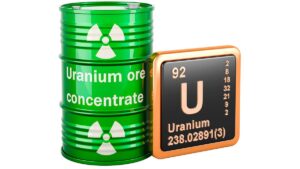‘Tilt your portfolio towards genuine megatrends’: Thematic ETFs could help retail investors capitalise on uranium’s renaissance

Pic: Stockhead, Via Getty Images
- Thematic ETFs combine the benefits of an ETF with exposure to long-term megatrends, like clean energy
- BetaShares Global Uranium ETF (ASX: URNM) provides exposure to a portfolio of global companies
- Investors are generally able to start investing in ETFs with as little as $500 via most brokerage platforms
What is thematic investing?
Thematic investing seeks to capitalise on long-term structural changes shaping our future, like clean/alternative energy, cybersecurity, or artificial intelligence.
Thematic ETFs combine the benefits of an ETF – namely convenience, diversification, and transparency – with exposure to these long-term structural changes.
“This means that investors are able to reduce stock specific risk when investing in a well-constructed exposure like our Global Uranium ETF,” BetaShares senior investment strategist, Cameron Gleeson, told Stockhead.
“This is an important consideration when looking at exposure to emerging industries, such as alternative energy, driverless cars or even robotics, as it is often much harder to pick individual winners in themes that are expected to play out over multiple decades.”
In terms of portfolio construction, investors should use thematic ETFs as portfolio ‘satellites’ to enhance returns, Gleeson says.
“The portfolio core should be based on low-cost ETFs covering large cap international and Aussie equities, fixed income and other assets of this nature,” he says.
“Thematic ETFs can then be used by investors to tilt the portfolio towards genuine megatrends.”
Let’s talk uranium
Megatrends include clean energy, which has seen nuclear power experience something of a renaissance.
Governments around the world are seeing it as a necessary part of the energy mix – both to meet their net-zero goals and to provide greater energy security in a time of heightened geopolitical tension, Gleeson says.
“New nuclear power stations are being built and the lifespan of existing facilities are being extended,” he says.
“Nuclear power requires fuel, namely uranium. The global uranium market already in a substantial supply-demand deficit after years of under-investment; which is driving uranium prices higher.
“In the longer term, as more nuclear power comes online there will need to be substantial investment in new uranium mines.”
The BetaShares Global Uranium ETF (ASX: URNM) provides exposure to a portfolio of global companies involved in the mining, exploration, development and production of uranium, or companies that hold physical uranium or uranium royalties.
Since inception on 8 June 2022 to the end of August, URNM had already returned ~10.77%.
URNM share price chart
URNM currently holds 36 companies including global companies Cameco and Kazatomprom, as well as an allocation to the well-known Sprott Physical Uranium Trust, Gleeson says.
In August 2021, the Sprott Physical Uranium Trust (SPUT) started buying up physical uranium, taking it out of market circulation.
It was proverbial “can of kerosene” on the spot price, which has since risen from ~$32/lb to about ~$US50/lb currently.
SPUT has stacked (removed) over 58.57m pounds of uranium since inception.
A gigawatt-class reactor uses around 450,000 pounds per year, so this is no small amount, says 808s Online, a blog run by a US nuclear professional.
URNM also includes advanced Aussie project developers like Paladin Energy (ASX:PDN), Boss Energy (ASX:BOE), Deep Yellow (ASX:DYL), Bannerman Energy (ASX:BMN), and Lotus Resources (ASX:LOT).
For those mining and energy investors looking for something besides yellowcake exposure, BetaShares also has a bunch of other commodity focused ETFs. The Australian Resources Sector ETF (ASX:QRE), for example, gives exposure to a portfolio of the biggest resources companies in Australia, including BHP (ASX:BHP), Woodside (ASX:WPL) and Rio Tinto (ASX:RIO).
Is it easy for retail investors to get involved in thematic ETFs?
Yes. Although ETFs generally don’t have a minimum investment amount, brokerage platforms tend impose limits of this nature, Gleeson says.
“As a result, investors are generally able to start investing in ETFs with as little as $500 via most brokerage platforms,” he says.
“Ultimately, investors should consider their own circumstances and goals before making any investment.”
Related Topics

UNLOCK INSIGHTS
Discover the untold stories of emerging ASX stocks.
Daily news and expert analysis, it's free to subscribe.
By proceeding, you confirm you understand that we handle personal information in accordance with our Privacy Policy.








